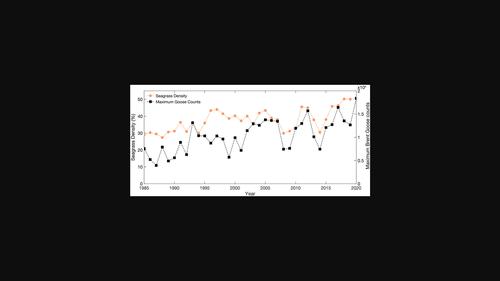Remote sensing in seagrass ecology: coupled dynamics between migratory herbivorous birds and intertidal meadows observed by satellite during four decades
IF 3.9
2区 环境科学与生态学
Q1 ECOLOGY
引用次数: 3
Abstract
Taking into account trophic relationships in seagrass meadows is crucial to explain and predict seagrass temporal trajectories, as well as for implementing and evaluating seagrass conservation policies. However, this type of interaction has been rarely investigated over the long term and at the scale of the whole seagrass habitat. In this work, reciprocal links between an intertidal seagrass species, Zostera noltei, and a herbivorous bird feeding on this seagrass species, the migratory goose Branta bernicla bernicla, were investigated using an original combination of long‐term Earth Observation (EO) and bird census data. Seagrass Essential Biodiversity Variables (EBVs) such as seagrass abundance and phenology were measured from 1985 to 2020 using high‐resolution satellite remote sensing over Bourgneuf Bay (France), and cross‐analysed with in situ measurements of bird population size during the goose wintering season. Our results showed a mutual relationship between seagrass and Brent geese over the four last decades, suggesting that the relationship between the two species extends beyond a simple grass—herbivore consumptive effect. We provided evidence of two types of interactions: (i) a bottom‐up control where the late‐summer seagrass abundance drives the wintering population of herbivorous geese and (ii) an indirect top‐down effect of Brent goose on seagrass habitat, where seagrass development is positively influenced by the bird population during the previous wintering season. Such a mutualistic relationship has strong implications for biodiversity conservation because protecting one species is beneficial to the other one, as demonstrated here by the positive trajectories observed from 1985 to 2020 in both seagrass and bird populations. Importantly, we also demonstrated here that exploring the synergy between EO and in situ bird data can benefit seagrass ecology and ecosystem management.

海草生态遥感:40年来卫星观测到的迁徙草食性鸟类与潮间带草地之间的耦合动力学
考虑海草草甸的营养关系对于解释和预测海草的时间轨迹以及实施和评估海草保护政策至关重要。然而,这种类型的相互作用很少在整个海草栖息地的范围内进行长期研究。在这项工作中,使用长期地球观测(EO)和鸟类普查数据的原始组合,调查了潮间带海草物种Zostera noltei和以该海草物种为食的草食性鸟类迁徙鹅Branta bernicla bernicla之间的相互联系。1985年至2020年,在法国布尔格涅夫湾上空使用高分辨率卫星遥感测量了海草基本生物多样性变量(EBV),如海草丰度和酚学,并在鹅越冬季节与鸟类种群规模的原位测量进行了交叉分析。我们的研究结果显示,在过去的四十年里,海草和布伦特鹅之间存在着相互关系,这表明这两个物种之间的关系超出了简单的草食性消耗效应。我们提供了两种相互作用的证据:(i)自下而上的控制,夏末海草的丰度驱动草食性鹅的越冬种群;(ii)布伦特鹅对海草栖息地的间接自上而下的影响,在前一个越冬季节,海草的发育受到鸟类种群的积极影响。这种互惠关系对生物多样性保护有着强烈的影响,因为保护一个物种对另一个物种有益,正如1985年至2020年在海草和鸟类种群中观察到的积极轨迹所表明的那样。重要的是,我们在这里还证明,探索EO和原位鸟类数据之间的协同作用可以有益于海草生态和生态系统管理。
本文章由计算机程序翻译,如有差异,请以英文原文为准。
求助全文
约1分钟内获得全文
求助全文
来源期刊

Remote Sensing in Ecology and Conservation
Earth and Planetary Sciences-Computers in Earth Sciences
CiteScore
9.80
自引率
5.50%
发文量
69
审稿时长
18 weeks
期刊介绍:
emote Sensing in Ecology and Conservation provides a forum for rapid, peer-reviewed publication of novel, multidisciplinary research at the interface between remote sensing science and ecology and conservation. The journal prioritizes findings that advance the scientific basis of ecology and conservation, promoting the development of remote-sensing based methods relevant to the management of land use and biological systems at all levels, from populations and species to ecosystems and biomes. The journal defines remote sensing in its broadest sense, including data acquisition by hand-held and fixed ground-based sensors, such as camera traps and acoustic recorders, and sensors on airplanes and satellites. The intended journal’s audience includes ecologists, conservation scientists, policy makers, managers of terrestrial and aquatic systems, remote sensing scientists, and students.
Remote Sensing in Ecology and Conservation is a fully open access journal from Wiley and the Zoological Society of London. Remote sensing has enormous potential as to provide information on the state of, and pressures on, biological diversity and ecosystem services, at multiple spatial and temporal scales. This new publication provides a forum for multidisciplinary research in remote sensing science, ecological research and conservation science.
 求助内容:
求助内容: 应助结果提醒方式:
应助结果提醒方式:


